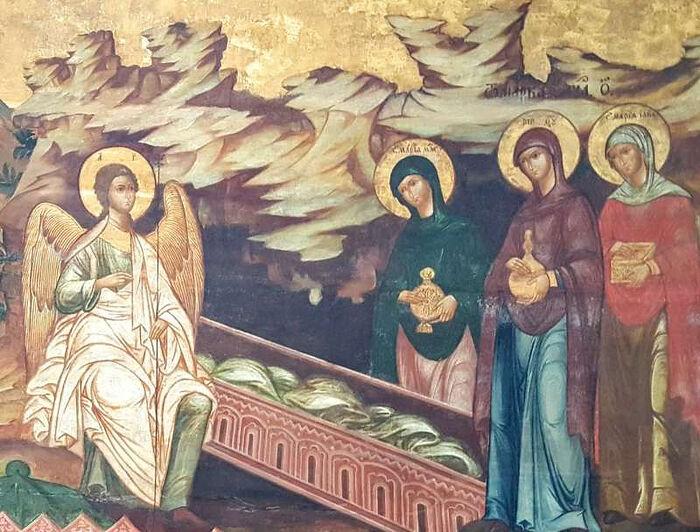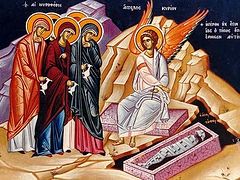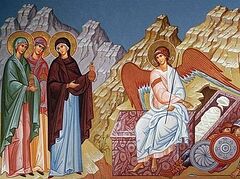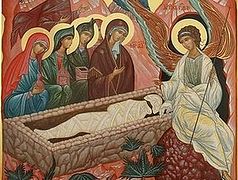These festal post-Paschal Sundays bring with them a series of commemorations. The Holy Church brings to mind resurrected men and women whose lives were altered drastically by their individual encounters with the Risen Christ. These are the first amidst the race of mankind who live the victory of the Resurrection. The supreme truth of Christ’s Resurrection becomes their own emboldening; they take this Truth and become witnesses of the Risen Christ from Jerusalem to Samaria and to the ends of the earth. Last Sunday we commemorated the Apostle Thomas, who doubted the Resurrection. His physical encounter with the Risen Lord led to a divine examination of Christ’s side and the print of the nails. Jesus invited Thomas to investigate the evidence of the Passion and the Resurrection. Today, we commemorate the Holy Myrhbearing Women and Sts. Nikodemos and Joseph of Arimathea, who endured with the Lord during His Holy Passion and Holy Crucifixion. These holy and faithful disciples, but feeble women in the case of the former, and old men in the case of the latter, nevertheless displayed courage and fortitude. They boldly ministered to the Lord in carrying out the prescribed funeral rites. Due to the pending Sabbath, they were forced to cease their work as they mystically participated with Christ (who lay resting in the Tomb) in the sacred Sabbath, and the prescribed rest from all works. Early on the Sunday of Pascha, the first day of the week, the women ran to the Holy Tomb with many pounds of precious myrrh in hand. As they would discover, the Tomb lay empty. The Resurrection had overtaken them. There they saw an Angel sitting upon the stone. He greeted them with these words and said: Why seek ye the living among the dead, why mourn ye the incorruptible amidst corruption?
We too are commissioned in Christ’s service to proclaim the Resurrection through living a Resurrected, fearless life. To do so, as one holy and righteous priest once said, we must become familiar with death—familiar in the sense that we reach the junction at which the ancient saying, “The brave man dies but once”, becomes our personal and intimate reality. St. Paisios the Athonite said that the brave and sacrificial soldiers during the Greek Civil War were the ones who consistently cheated death. Those who walk in the light of the Resurrection move in the world amidst the deadly grasp of Hades; amidst our dark reality they spread the Truth of the Resurrection. We spoke just now on bravery in the face of death. The Women Disciples of the Lord heard from the radiant angel the news of the Resurrection, and immediately their souls and hearts were fortified with a strange strength. They became emboldened with an unimaginable courage. Nothing could inhibit the Resurrected Christ and those who were enlivened by His Resurrection. Immediately the Holy Women ran to evangelize the Apostles and to proclaim Christ God is Risen. Though in the Garden of Eden a woman brought deceit and death to man, from the garden of the Life-Giving Tomb the Holy Women bring the news that the curse is annulled, Adam and Eve are redeemed, and death is destroyed. In this act of selflessness shown by the Myrhbearing Women we find a model for service, for διακονία, and for ministry in the Church. Too often in our individualistic society—an individualism that many of us, unfortunately, consciously or unconsciously happily embrace—we ask: What can Christ do for me? What can the Church do for me? How can God help me? Moreover we place demands on God. But this is due to our human weakness. We have not yet been transfigured by the Resurrection.
What a contrast to the spirit and valor exhibited by the holy women disciples and by St. Joseph of Arimathea and Nikodemos, the secret disciple! They—and the countless Saints through history—said to Christ: Lord, how can we serve You? How different is our initial beginning: The source of their desire and motivation is their service to God. Our prime motivation is God serving us. We begin and end on different ends of an eternal spectrum. There are many illnesses, mental and physical, in this world today, and no one is at fault but man and his ego. We are the creators and instigators of our own death, illness and destruction. The Canadian philosopher Jordan Peterson teaches that man should take responsibility for himself. This is a fundamental concept for spiritual and mental healing. Instead of seeking solutions at the source of Life, which is Christ and His defeat of death in and through His Holy Resurrection, we will consistently commune with death and the devil and their shadowy and ill concieved plans to our own damnation and destruction by avoiding the source of blame: our fallen nature. We want solutions to our problems? We want to participate in immortality? Then let us live in the Resurrection. The Church has presented to us on this auspicious Third Sunday of Pascha radiant examples of what we ourselves can become if we will walk in the light of Christ’s Resurrection. So then, why the hesitation to grasp the rays of immortality that come forth from the Timeless Night of Christ’s Holy Pascha?
The answer is this: Our communion with sin grasps and chokes us. St. Ignatius (Brianchaninov) in his homily for this Sunday says that we are plagued by a passion called INSENSIBILITY. We are, as it were, under a spiritual paralysis or anesthesia. We are unable to awaken to the truth of Christ and His Resurrection. We cannot act by the Resurrection, and we do not live by the Resurrection. The Holy Myrhbearing Women gave selfless gifts to Christ—the Myrh—and Christ in turn gave them the gift of immortality by the Resurrection. Myrh is meet for mortals, Christ is shown immune to corruption! And what immeasurable gift of immortality will we also receive when we build Christ’s Church here, in this town where we live? And now I call all of you present today at this Liturgy: We must pour our resources and energy into the building of a magnificent temple wherein the victorious and Risen Christ God will manifest Himself in the Holy Eucharist on each Sunday—the day we commemorate His Bright Resurrection. We think we are giving to Him—and how wrong we are in this assumption, according to St. Ignatius. Our dedication of our life and all our strength and abilities to the service of God are not needed by God for Himself—they are needed by us. We bring them like myrrh to the Lord’s tomb. Whoever enters into service of God from the very days of an unspoiled youth and remains in this service with constancy submits himself to the endless influence of the Holy Spirit, marks himself with the all-holy grace-filled impressions that emanate from the Spirit, acquires in good time an active knowledge of Christ’s Resurrection, comes alive in spirit in Christ, and becomes chosen by God to be a preacher of the Resurrection.
Our purpose is to selflessly give of our time, of our financial means, of our emotional and psychological abilities to a) Christ b) the Church both as an institution (the local parish level) and c) the Church as the Body of Christ; meaning, to support our brethren, beginning with our own nucleus—the family unit—and from there expanding outwards. Each does this according to his or her own abilities and talents. By living this life of διακονία we become alive in Christ—and like the Myrhbearers—we take our source of strength from the Resurrection. And others come to believe by the preaching which gushes forth from a Resurrected life lived by each Christian man and woman. This is not a preaching of words, but of actions, and of spiritual energy. The manner of conduct of Joseph of Arimathea and Nikodemos—who boldly sought the Body of Jesus from Pilate at a time when the disciples were in hiding from fear—and the action of the Myrhbearers, did not only show dedication: their actions showed bravery. Let us ask: Are we brave Christians? Do we go with the flow of society, or do we swim against it? This is the ultimate question that the Holy Church places before us on this Sunday: What impact—if any—has the Resurrection had on my life? And, am I transfigured by the Resurrection? Have I become a bold witness to the world of Christ’s Salvific Passion and Crucifixion and His defeat of death in the Resurrection?
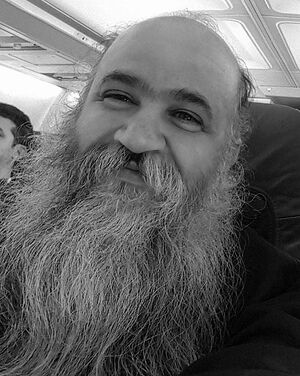 Few, ultimately, are such witnesses to the Resurrection. I knew such a priest in my time—Fr. Emmanuel Kontakis of the St. Athanasios Parish in Oreokastro, Thessaloniki, who reposed this past week at the young age of 51. After almost 30 years of priesthood, he was just such a witness to the Resurrection. The blessed one was a tireless laborer in Christ’s vineyard; his ardent faith and sense of priestly conviction enabled him to serve daily. Never was the bell silent in the mornings and evenings for Matins and Vespers—it rang over the hamlet, calling the Christians to prayer and worship and communion with Christ. Rarely did a weekday pass when the Liturgy was not served. He sought out the last sheep of his parish to share with them the joy of the Resurrection—day in and day out, week in and week out, three hundred sixty-five and a quarter days a year, for thirty years. I was blessed to be with him for about a year and a half as a layman. From his parish I left to be ordained on New Years Day, 2017. That was the last time we saw each other here. I didn’t always listen to him or appreciate him; I admittedly took this kind priest for granted. Then later as time went on, my own pastoral responsibilities and the trials of life came along, and I couldn’t find time to visit Thessaloniki. Pay close attention, and appreciate one another as brethren in Christ. I hope that Fr. Emmanuel will pray for us. I hope that he will help us by his prayers to become emboldened witnesses to Christ’s Resurrection. The day is long past. We have much wood to cut. Let us make a beginning!
Few, ultimately, are such witnesses to the Resurrection. I knew such a priest in my time—Fr. Emmanuel Kontakis of the St. Athanasios Parish in Oreokastro, Thessaloniki, who reposed this past week at the young age of 51. After almost 30 years of priesthood, he was just such a witness to the Resurrection. The blessed one was a tireless laborer in Christ’s vineyard; his ardent faith and sense of priestly conviction enabled him to serve daily. Never was the bell silent in the mornings and evenings for Matins and Vespers—it rang over the hamlet, calling the Christians to prayer and worship and communion with Christ. Rarely did a weekday pass when the Liturgy was not served. He sought out the last sheep of his parish to share with them the joy of the Resurrection—day in and day out, week in and week out, three hundred sixty-five and a quarter days a year, for thirty years. I was blessed to be with him for about a year and a half as a layman. From his parish I left to be ordained on New Years Day, 2017. That was the last time we saw each other here. I didn’t always listen to him or appreciate him; I admittedly took this kind priest for granted. Then later as time went on, my own pastoral responsibilities and the trials of life came along, and I couldn’t find time to visit Thessaloniki. Pay close attention, and appreciate one another as brethren in Christ. I hope that Fr. Emmanuel will pray for us. I hope that he will help us by his prayers to become emboldened witnesses to Christ’s Resurrection. The day is long past. We have much wood to cut. Let us make a beginning!

